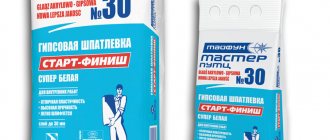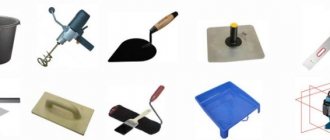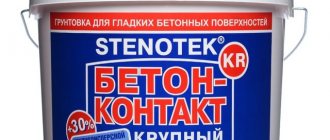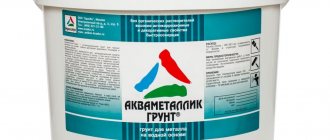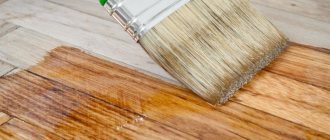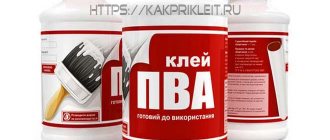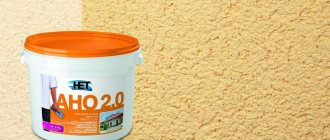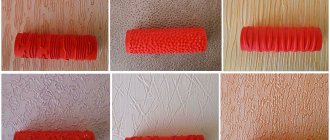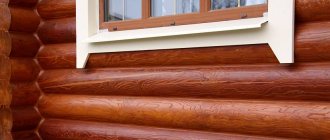Why do you need putty?
It can be used to level surfaces made from a variety of materials—everything can be puttyed. It's just a matter of choosing the right material.
What can be treated with putty:
- Stone.
- Concrete.
- Brick.
This material has proven itself in working with slopes (doors and windows), when finishing arches, etc. Start putty is not much different in appearance from the finishing mixture, but has a denser structure and is cheaper.
Characteristics:
- Ecological cleanliness.
- Quick drying.
- High resistance to cracking.
Nowadays, there are mixtures for both exterior and interior decoration. This must be taken into account. If facade putty is used for interior decoration, then such a coating will not last long, and the repair will soon need to be done again. And if you take the mixture for interior work and putty it on the facade, it will become unusable even earlier.
In both cases, the result is the same: wasted time, material and money. In addition, the old coating will have to be completely removed, which is not a very pleasant task, considering the amount of dust that will be released during this work. To prevent this from happening, you need to consult sellers and managers of construction markets, and also carefully read the instructions on the packaging.
If you have reason to believe that, due to your inexperience, you can ruin the solution due to little experience in such work, because you are doing it too slowly, then it is better to purchase a product marked “max putty.” It is better to make less solution at first so that you have time to use it before it hardens.
Popular manufacturers
It is recommended to buy putties from well-known brands. This guarantees high quality of the mixture, durability of the resulting coating and compliance with the declared properties.
List of the most popular companies:
- Knauf is a leader in the finishing materials market. The company offers building mixtures of any composition and for any work: cement and polymer plasters, gypsum leveling mixtures, accompanying materials, such as primers.
- Ceresit is an equally famous name. The line is slightly smaller, but includes all possible options for external and internal work. Products are produced in the form of pastes and dry mixtures.
- Weber-Vetoni is a standard of quality. Produces finishing materials for a wide variety of purposes. A distinctive feature is that the putty does not shrink when dried.
Source
Composition and technical characteristics
Both the base (starting) and finishing putty have a similar composition. The main differences are the viscosity of the consistency and the size of the filler fraction.
Differences in composition:
Cement starting putty contains different types of cement. They are characterized by different colors, with different saturations. A distinctive feature of cement putty is its resistance to moisture. If a large layer is applied, damage may occur due to drying. They are best used for finishing buildings, facades, bathhouses, kitchens and other concrete surfaces.
Gypsum putty for walls – white. This is due to the presence of gypsum as the main structural element. Distinctive features are elasticity and shrinkage when drying. Due to the presence of gypsum in the composition, drying time is much shorter than other types.
Polymer – based on polymer compounds. Colors are light brown and white. The main feature of this type is its long service life and ease of use. It is easy to use and has unique construction properties.
Consumption per 1 m2
Material consumption primarily depends on the type of surface.
What affects material consumption:
Depending on the components used in the putty, the consumption may also depend. For example, gypsum starting soil requires less consumption and dries quickly.
On a flat surface, soil consumption is 800-900 gm3. If the surface is as uneven as possible, with large protrusions, then the consumption increases significantly, and reaches 8 kg per m3.
Important. The layer density should not be more than 10 mm, otherwise the efficiency will be reduced. There is a possibility of destruction of the structure, since the layer will not support the weight and will collapse.
Purpose
Many people have heard about such a building mixture as putty start. It is also sometimes called putty. But at the same time, only a few know what it is and what it is intended for. Usually these are professional builders who have carried out more than one repair with their own hands. But for people who are new to this business, such knowledge will help not only to correctly apply the solution for its intended purpose, but also to use it to make high-quality finishing of walls and ceilings.
In terms of its composition and purpose, starting-type putty is somewhere in the middle between mixtures used for finishing leveling of various surfaces (walls and ceilings) and plaster. But the structure of such putty will be somewhat finer than that of plaster, but larger than its other names. Today, the most popular manufacturer of building mixtures, including this mortar, is the German company Knauf.
At the same time, if during the repair one Knauf mixture was used, then in choosing the rest it is also worth giving preference to this brand. In such a situation, there will definitely be no problems with the quality of the finish.
The main purpose of any starting putty (Knauf or other manufacturer) is to level rough surfaces. These include the following types of surfaces:
- brick walls;
- concrete floors;
- plastered walls and ceilings;
- surfaces that have a significant deviation from level;
- surfaces with obvious defects in the form of cracks, chips and potholes.
There are situations when starting putty is applied to a reinforced layer (fiberglass mesh). This approach is used for severe unevenness. In case of minor deviations in level, the putty is applied in several layers. At the same time, its consumption increases significantly compared to the method with fiberglass mesh. You should always remember that the consumption of any brand of mixture (Knauf, etc.) will be determined by the thickness of the applied layer. Consumption is usually determined per 1 m2 of treated surface. Therefore, the mixture must be purchased taking this parameter into account.
Starter type putty is suitable for the following types of work:
- filling the grooves;
- finishing door and window openings around the frame;
- sealing joints formed between ceiling and wall reinforced concrete panels;
- alignment of window slopes.
Please note that for interior and exterior work, you should use different types of mixtures, the characteristics of which correspond to certain operating conditions. For example, when working on a façade or finishing seams on balconies, you should only use putty that is intended for exterior work.
Kinds
Manufacturers who create starting putty usually use:
- gypsum;
- polymer binders;
- cement;
- lime.
The proportions depend on various nuances, as well as on which manufacturer produced the particular putty material. Today, many specialize in the production of basic putty, and so on.
When choosing the right material, you can read consumer reviews and review ratings. It is recommended to give preference to well-known manufacturers who have gained a good reputation.
Materials that contain a particularly large amount of cement are very resistant to liquids. For this reason, they are well suited for both interior and exterior finishing work. They are used to treat surfaces in rooms with high humidity. However, such materials also have disadvantages: they are distinguished by a rich gray color, which is very difficult to hide with thin wallpaper, and they also shrink significantly after some time.
Dry gypsum putties have a beautiful white color and are more aesthetically pleasing. However, such materials should not be used in rooms with high humidity.
Putty materials based on polymer binders are very popular. These are, for example, acrylic materials. Such putties have the following advantages:
- they can be used for application to a wide variety of surfaces;
- they do not shrink over time;
- they are easy to apply;
- they are characterized by increased elasticity.
Homemade
If you need to save money on purchasing branded starting putty (Knauf, etc.), you can make this type of building mixture with your own hands. Let's look at how to prepare this or that putty with your own hands in more detail:
- Gypsum-chalk mixture. It is used for leveling plasterboard and concrete walls in dry rooms. To prepare it, you need to mix 3 parts chalk with 1 part gypsum in a dry bowl. Gradually stirring the mixture, pour it into a container with a 5% solution of animal/wood glue. All this should be mixed until smooth. The homemade solution should be used immediately, as it hardens quickly;
- Oil mixture. It is used for wooden surfaces that will be used in conditions of sudden temperature changes (wooden window frames, facades, etc.). To make such a homemade mixture, you will need to mix 1 kg of drying oil with 2 kg of chalk. After this, add 100 g of drier to the resulting mixture and put it all on the fire. Bring the solution to a boil and cool it. This mixture should be used warm.
Let us remind you that the putty consumption here will be greater than that of purchased ready-made mixtures.
Ready mixes
Start putty is sold ready-made. Such ready-made mixtures come in the following types:
- Cement. They are characterized by moisture resistance, but they are able to shrink when dry. They are gray in color. Used for finishing window and door openings, facades and rooms with high humidity;
- Plaster. Such mixtures dry quickly, are elastic and do not shrink, but they are not at all resistant to moisture. Used for finishing ceilings and walls in well-heated and dry rooms;
- Polymer. They are characterized by elasticity and durability, do not shrink and are very convenient to use. They are white in color. Their only drawback is their high cost.
The following ready-made mixtures can also be used for finishing metal, wood and other structures:
- oil;
- epoxy;
- adhesives and other special putties.
Each ready-made solution of starting putty has its own consumption, which should be remembered when choosing it in the store. The thickness of the layer applied to the surface also affects the consumption. These two parameters should be taken into account when determining the volumes of finishing material required.
Purpose and properties of the material
A plastered surface is rarely perfectly flat. The structure of this finish is too large, so even after smoothing it retains its specific texture. If the wall is covered with thick wallpaper after plastering, this does not matter much. But if you have to paint, especially with glossy paints, or paste with thin fabric wallpaper, you need to use putty.
Putty composition is a means for leveling concrete and brick plastered surfaces. Its task is to create a smooth surface without visible flaws. The mixture fills seams and chips, compensates for curvature, but not more than 5–7 mm. After puttying, the walls and ceiling become perfectly smooth, but rough.
Characteristics
The putty mixture is produced in finished form. The composition must be diluted as indicated in the instructions. The entire prepared volume should be used, as it hardens quite quickly and is not further diluted.
Characteristics of the putty:
- the maximum permissible layer thickness is 1.5 cm;
- consumption – 1 kg per 2–5 m²;
- quick drying - within a few hours;
- ability to reduce structural noise levels.
Apply putty in several layers. A 1.5 cm layer will not stay on the wall.
Scope of application
Starting putty is used for the following work:
- leveling walls and ceilings, filling minor defects;
- alignment of seams remaining after filling deep cracks;
- sealing window and door openings;
- leveling slopes;
- sealing joints between sheets of drywall;
- filling joints between wall and ceiling.
On the outside, putty is required when leveling external slopes. Here they use special compounds that are resistant to atmospheric conditions.
Advantages and disadvantages
Starting soil, or base soil as it is called, has positive and negative characteristics. Basic because it is required for almost all finishing works. After the base primer, the finishing primer is applied.
- easy to apply;
- handles irregularities and crevices;
- hardens quickly;
- used to cover various surfaces.
There are practically no disadvantages to starting soil. The relatively high price of popular manufacturers is one of the main problems. Consumers often save money by not purchasing a quality product, after which problems associated with destruction begin.
Gypsum putty 2 in 1 (Start+Finish)
A very useful finishing material that allows you to save on the time allotted for finishing walls. The price of this putty is noticeably higher than that of the starter and final set, but it also has its drawbacks.
Compared to the final one, it is tougher and more difficult to sand than the final one. Compared to the starting one, it is less rigid and layers that are too thick will simply float. But still, for finishing work of low complexity it is an ideal option, especially for inexperienced specialists.
How to choose?
If you are aiming to obtain coatings that will last as long as possible and will not cease to be aesthetically pleasing over time, use materials from the same manufacturer (and belonging to the same series) in the same room. When planning to purchase putty, first find out the expiration date and read the instructions.
Do not use putty solutions for interior finishing work that are intended for treating external surfaces. Otherwise, cracks may appear on the surface, after which you will have to make repairs again.
If you are a beginner, but want to handle everything yourself, opt for Maxi materials. Putties with this mark harden for quite a long time, so you will have the opportunity to carry out finishing work without undue haste.
No. 3. Types of putties according to degree of readiness
There are few options here - putty can be sold in two versions:
- a dry mixture that requires dilution with water in strictly defined proportions;
- ready putty.
Dry mixtures are sold most actively, as they are inexpensive and have a longer shelf life. Such putties are sold in bags weighing from 5 to 25 kg; they are easy to transport and store. To obtain the necessary paste-like putty from dry powder, it is enough to mix the composition with water in a certain amount. It takes a little time to mix and mix, but the putty obtained in this way sets quickly, so you need to work quickly, and mixing the material in large batches will not work. To obtain a solution with clearly specified parameters specified by the manufacturer, you must act strictly according to the instructions. Some also consider the need to spend time preparing the solution as a disadvantage, but, to be honest, this is not a very large time investment. Another disadvantage is the presence of dust during mixing.
Ready-made formulations are sold in buckets or large tanks. It is not difficult to guess that they can be used immediately, which saves time and eliminates the risk of disturbing the proportions and getting putty of a completely different quality. Additional tools and containers are also not needed. The shelf life of the finished composition is less than that of dry putty, but much longer than that of dry putty diluted from powder. Ready-made formulations are more expensive than dry ones.
Characteristics of Knauf starting putty
Recently, Knauf starting putty has been increasingly used for interior work. This is a high-quality product, manufactured using German technologies and meeting international quality standards. This type of putty is a gypsum version; it is intended for repair work in rooms with normal humidity.
Knauf brand putty is considered an environmentally friendly product, so it is harmless to human health, thus it can be used to carry out work in children's rooms and medical institutions.
The putty mixture in buckets is a ready-made composition that can be used by anyone. The starting version of Knauf putty can be purchased in bags of varying weights, starting from 5 kg. The positive qualities of the material include:
- strength and reliability;
- low consumption;
- coating quality;
- fast drying time;
- good additional sound insulation.
The only disadvantages of starting putty for walls are that it hardens quickly, as well as the inability to create a sufficiently thick and high-quality layer. The manufacturer regulates the maximum layer of putty to be applied as one and a half centimeters. It is quite enough to hide visible defects and cracks in walls or ceilings.
This putty cannot be used for exterior work, since the gypsum included in its composition does not tolerate moisture.
Product varieties
Knauf starting mixtures are available in several types:
- Knauf HP Start;
- Knauf Rotband;
- Knauf Goldband.
The first type is considered universal, as it is suitable for application to concrete, brick, plasterboard and even polystyrene foam walls. This option can be used for renovation work in bathrooms and kitchens. Knauf Start putty has a number of advantages, including:
- moisture resistance;
- environmentally friendly, contains no harmful components;
- reliability, no shrinkage after complete drying.
If you follow all the rules described in the instructions, you can get a fairly smooth wall on which you can apply the finishing layer.
Rotband putty can be distinguished in three shades: white, gray and pink. The thickness of the applied layer can vary from 5 to 30 mm. The time for complete drying of the material is usually 7 days. Sold only as a dry composition in paper packaging.
Even if water gets on the wall, the putty will not slide off and will retain all its quality characteristics. Rotband material also has high fire resistance, which proves the safety of the material, and good thermal insulation.
The third type is intended for application only on vertical planes, that is, on walls, because the composition does not contain an adhesive base. The putty simply will not stick to the ceiling, even with a high-quality primer layer. Another significant difference is the fairly thick application layer - it can be applied up to 50 mm. With such dimensions, the composition fits well on brick and concrete walls.
Finishing gypsum putty
This material is applied to an already prepared surface, namely to a layer of starting putty. This composition is dominated by gypsum and is softer than the starting one, so it is very easy to sand.
After completing the work with the final layer, the wall is ready for further work and is perfectly level (subject to technology and high-quality work).
Technology of working with putty
In any work you must follow certain rules. This is when the quality of work and long service life of the surface are ensured. Starter putty is no exception to the general rules.
Before puttying you must:
- Clean the surface from dust and dirt. Plaster that does not adhere well, is swollen or crumbling should be removed to the base of the wall. To carry out these preparatory work, you will need a steel spatula and other tools: a metal brush, a hammer, a grinder, etc.
- Before applying the material to the plastered wall, you need to remove dust with a vacuum cleaner or damp sponge.
- If there are greasy and oil stains, you should use solvents: acetone, gasoline, etc.
- Primer follows - an operation that cannot be ignored in order to avoid subsequent shedding or peeling of the applied putty. The primer is applied in several layers depending on the porosity of the surface. It is not at all necessary to wait for each layer to dry completely, but the last layer must be dried strictly according to the technology - this is indicated on the packaging. Deep penetration soil should be used.
It is important to note that the primer must be compatible with the putty in composition. The finished putty should be thoroughly mixed before use. If it was stored for a long time, its components separated. Mix using a mixer.
Gypsum and cement mixtures are sold in dry form. Water must be added to such materials in strictly defined proportions indicated on the packaging. To do this, first water is poured into the container in the required quantities, and only then the mixture is poured in with continuous stirring. The finished solution is kept for up to 15 minutes and mixed again.
Tips for applying the material
As already mentioned , to increase adhesion (adhesion of the mixture to the surface being repaired), the walls must first be primed with a deep penetration primer so that the thick layer of coating does not peel off (swell) over time. Proper preparation of the walls guarantees a successful renovation.
- You should scoop up the solution with a spatula in large quantities and apply it to the surface with broad strokes, energetic, confident movements.
- The spatula should be pressed tightly against the wall, maintaining the same angle of contact.
- If there are sagging, they are smoothed out with a clean spatula or removed altogether.
- If the unevenness is significant, then you need to let the preliminary layer harden a little.
- The walls are sanded only when the mortar has completely hardened.
When the walls in a room are not very smooth, as is often the case, this can be quite easily eliminated with starting putty if you have certain skills in working with the material. All defects can be corrected. To make large planes (walls, ceilings) perfectly flat, you need to use a special tool - a rule.
Only after you have finished working with the putty, sanded the wall and achieved a smooth surface, can you begin to cover it with the finishing material.
Making putty at home
Preparation of putty from soap solution and chalk
You can also prepare the putty yourself.
- If you are going to paint the wall after puttingty , mix 1 part gypsum with 3 parts chalk. Add a 5% PVA solution to the dry mixture and mix to obtain a uniform consistency. The mixture hardens in about the same way as PVA glue.
- Another option: 1 liter of drying oil, 3 kg of chalk, 100 g of 10% wood glue solution. The composition is quite suitable for external work.
- If you are going to use oil paint , grate a piece of laundry soap, pour boiling water over it and wait until it is completely dissolved. Then 1 liter of drying oil is poured into the still hot solution and 3 kg of sifted chalk is added.
- To work with old walls, prepare a mixture with antibacterial properties. To do this, add 150 ml of a 10% solution of wood glue to 1 liter of vitriol primer and mix. Then gypsum is gradually introduced until a thick dough-like consistency is obtained. The mixture must be used immediately; it sets very quickly.
The better the chalk is crushed, the more finely dispersed the putty is.
Exceptions
Experienced painters rarely use instructions: they have a trained eye, and how much to pour into the container also depends on the hardness of the water. The manufacturer doesn’t know what thickness of layer you need, so he writes average proportions, and the material of the walls plays a role here. You will have to apply a thinner layer to the concrete, otherwise the entire composition will simply float away.
Try an experiment: prepare a slightly more viscous mass than you need and time its hardening time. Compare with an ideal solution: you will see that the saturated putty will harden 2 times faster. So, when working with a dense mass, you will have to forget what a smoke break is. While there is still putty diluted to the desired consistency in the bucket, you will have to work tirelessly.
Frozen putty is difficult to wash out, and you will also waste time. If you can’t live without rest, then buy 2 containers. Sometimes force majeure circumstances (an urgent call from your wife to the kitchen with borscht or diarrhea) will force you to lose the time you need for work.
The best universal putties
In some cases, when you have to finish interior spaces, dry and wet, as well as work outside the house, it is beneficial to buy a universal puttying material.
There are universal putties that are immediately suitable for leveling and finishing. In dry and damp rooms, during interior and exterior work, they can be used to level walls with only minor defects and differences. Therefore, in case of significant unevenness, you will have to use the traditional two types of putty: starting and decorative.
Knauf Fugen putty based on gypsum
The universal composition of Knauf Fugen putty allows you to work with completely different types of surfaces. The dry mixture is available in convenient bags weighing 5, 10 and 25 kg. Depending on the additives, the putty can be specialized: Knauf Fugen GV - for the surfaces of gypsum fiber sheets, Knauf Fugen Hydro - for the surfaces of moisture-resistant plasterboards.
Universal putty Knauf Fugen
Knauf Fugen putty is a durable, non-shrinking material that creates a monolithic surface without cracks. Its versatility is expressed in its use for fastening wall panels, as well as gluing gypsum elements to each other and to walls and ceilings. The environmentally friendly mixture dries quickly after application and is used sparingly, since the layer should not be thicker than 5 mm.
VGT acrylic universal putty
VGT acrylic-based putty is universal and is considered the most convenient to use. Acrylic today is one of the materials used, which is part of many construction finishing products. Thanks to acrylic, VGT acrylic putty is moisture and frost resistant, perfectly masks seams and cracks in concrete, plaster, brick, wood, and particle boards.
VGT acrylic universal putty
It is used inside and outside buildings with a layer thickness of 1 to 7 mm. Builders like VGT acrylic putty because it has high adhesion and easily lays on the surface in an even layer. Professionals skillfully use it not only for starting, but also for finishing.
Puttying the surfaces of the walls and ceiling of your home will be a quick and uncomplicated process if you become familiar with the sequence of actions and correctly select high-quality dry mixtures, which Russian and European manufacturers succeed in creating. In our online store of building materials "Kuzmich24" you will find most of the best putty products from well-known manufacturers at an affordable price.
Your Kuzmich.
Dry mixture or ready-made putty?
Let's figure out which putty to choose: semi-finished or ready-made? Firstly, let's start with the fact that the technical and operational characteristics of the two options are no different. It's the same material. It’s just that one is sold dry, the second ready-made. Ease of use is the basis here.
Ready-made putties can be used immediately. True, there is one “BUT” in this scenario. In the factory, the material is effectively diluted with water. It is one hundred percent correct, because it is controlled by the manufacturer. The semi-finished mixture will have to be stirred with water manually. And there is a possibility that the proportions may not be maintained.
Plus, the ready-made mixture is more expensive. This is understandable, because an additional technological operation is performed, and plastic containers are more expensive. True, the shelf life of the finished solution is shorter.
As you can see, not all solutions can be universal. Each has its own purpose. Therefore, when purchasing, pay attention to their technical characteristics and scope of application. The best option is a universal type. We invite you to discuss the topic of the article and decide which putty is better.
source: //ogipse.ru/201-harakteristiki-luchshih-shpaklevok-ot-shitrok-knauf-yunis-i-vetonit/
Polymer putty
The construction market is replete with new products. Manufacturers are trying to make the lives of their customers simpler and their products more in demand. It was for this purpose that polymer putty was developed.
This material is used for processing walls and ceilings at the penultimate stage of finishing, followed by decorating the surfaces - painting them or wallpapering them.
Finishing putties that you choose
Correcting minor defects after the initial leveling of the walls - this is the role of the finishing putty. With its help, walls are prepared directly for wallpaper and painting. An even and smooth surface is obtained due to the fine-grained nature of the finishing mixture. If you choose a grain size of 100 microns, you will get ideal walls for further painting.
The finishing putty is applied in 2 layers, then it is easily processed, since its strength is lower than that of the base material. The maximum thickness of the finishing putty layer should not exceed 5 mm. Just like the starting putty, the finishing putty can be based on cement, gypsum and polymer.
Finishing putty Knauf Rotband
Without much effort, you will achieve perfectly smooth walls for painting and wallpapering with the finishing gypsum putty “Knauf Rotband Finish”. Polymer additives ensure the absence of cracks on the surface and shrinkage after rapid drying. Such material can correct decent curvatures in walls.
Finishing putty Knauf Rotband
The putty is used for internal use in the preparation of surfaces made of concrete, plasterboard, and also plastered with gypsum and cement mixtures. Rotband finishing putty can be applied with a thickness of 0.2 to 5 mm.
Finishing putty “Prospectors”
The advantages of putty from for finishing work are high hiding power and whiteness of color /
Finishing putty Prospectors
Thanks to this, when preparing walls and ceilings with any surface - concrete, plaster, brick, you can save a lot on finishing putty: the minimum layer thickness can be only 0.3 cm. Modifying additives included in the mixture give the material high moisture resistance.
Finishing putty UNIS
The UNIS company suggests using highly plastic gypsum putty as a final finish before painting ceilings, which can be applied in a layer of 0.1 mm. UNIS putty mixture ensures easy sanding and ideal layer mixing.
Finishing ideal putty UNIS
The company's developers also presented a new product: finishing polymer putty UNIS LR Plus “White Pearl” with superplasticity properties, antibacterial additives and the ability to obtain a smooth and perfectly white surface.
